 Beer may be my passion, but in recent months, I've come to learn that a beer can sometimes only be as good as the vessel in which you enjoy it.
Beer may be my passion, but in recent months, I've come to learn that a beer can sometimes only be as good as the vessel in which you enjoy it.
A shaker pint glass does the trick in a pinch, but when it truly comes to experiencing a beer to the highest degree, it's important to consider what you pull from your cupboard. While I've shared my thoughts previously on the importance of glassware, I've was recently presented a serendipitous experience to explore how the method of drinking our beer impacts our senses.
And honestly, I think this latest experiment offers a rather curious take on the matter.
Here's the setup:
I'm about to enjoy Lagunitas NightTime, a black IPA, when I thought, why not break it into two glasses and see what happens? With my handy Spiegelau IPA and stout glasses in tow, I split the 22-ounce bomber between the two in order to see if there would be any significant difference in the experience.
There was.
Forgoing specific impressions of flavor, I instead focused on two important aspects of these two glasses:
- What did the beer "feel" like?
- Was there (generally) better aroma or taste?
As for #1, it was easy to compare/contrast because the stout glass is made for the purpose of impacting a beer's mouthfeel. Between the two glasses, the stout glass was far and away better at this, offering a much creamier consistency than the IPA glass.
But #2 surprised me. The typical "dank" hop aromas I experience with Lagunitas beers was better in the stout glass than the IPA. Both glasses are meant to accentuate aromas of each style of beer - the IPA glass with hops and the stout glass with " roasted malt, rich coffee and chocolate notes," which I truly believe it does.
Then I realized something else. Not only was the stout glass offering stronger sensory experiences, but it was keeping the beer colder, too. I even took out a thermometer to check. Over about 20 minutes of monitoring, NightTime stayed 2 to 3 degrees colder in the stout glass compared to the IPA glass as they both sat on my coffee table, only being touched when I sipped from either.
That's weird because to put it plainly, higher temperatures should generally mean stronger flavors.
So if I'm drinking a black IPA from now on, that stout glass seems very enticing.
But that was just the start of my experiment.
To try and better grasp what was going on, I followed my unscientific NightTime experiment with two more the next day in the same time frame as the first, between 8 and 10 p.m., when my house is sitting at about 74 or 75 degrees F.
First, I recreated the experience with a homebrewed IPA. Splitting half my 12-ounce bottle between the two glasses, I tracked temperature inside each glass over 15 minutes, taking four readings: one right after pouring, then 5, 10 and 15 minutes later. I left each glass untouched on my kitchen counter and only used my thumb and fore finger to pick up a glass by its stem to take a sip.
I poured the IPA directly down the middle into each glass, which caused noticeable more foam in the stout glass, which is on the left:
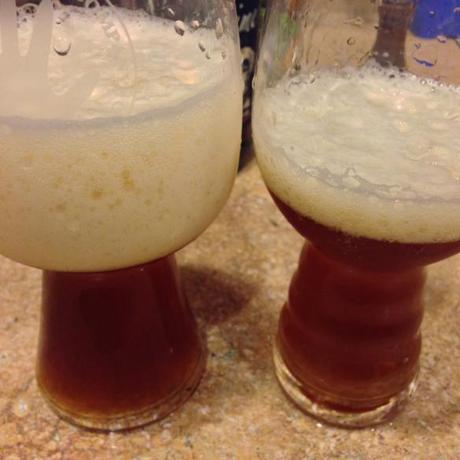
For reference, I stuck the thermometer about halfway down each stem of each glass, so it was getting ambient temperature from where the beer would recirculate most. I've highlighted the location:
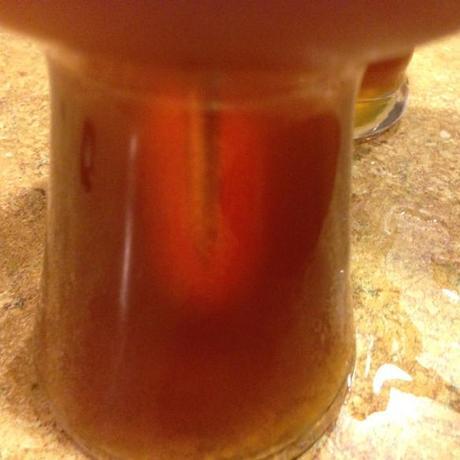
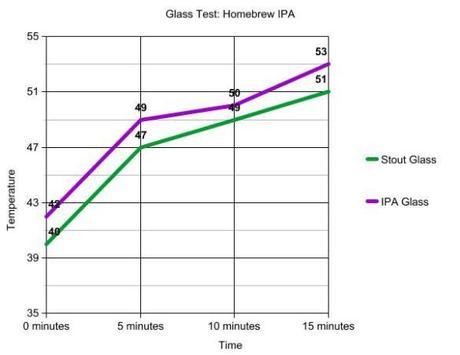
After the 15 minutes, I poured all of the leftover beer into a third shaker pint glass and took my time finishing it. I rinsed out both the stout and IPA glasses under cold water on the "coldest" setting my tap would allow for 10 seconds each.
As a secondary aspect, I set up the same experiment with Ska Brewing's Estival Cream Stout. Splitting a 12-ounce can between the two glasses, I followed the same steps as above. Again, the stout glass, left, started out with more foam:
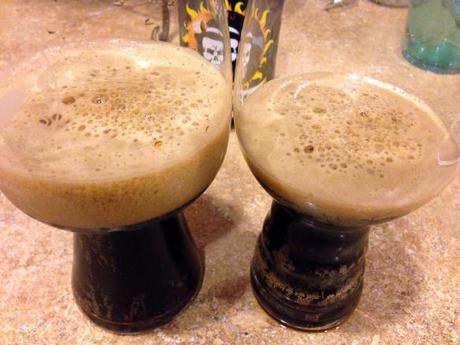
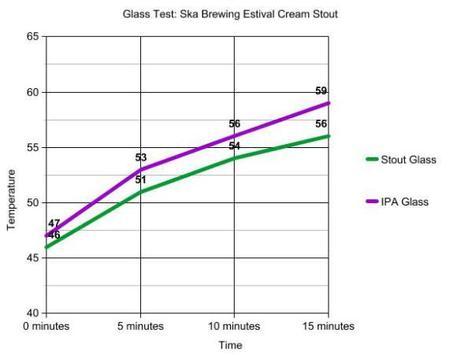
What makes me most curious about all of this is the mystery of temperature and beer characteristics. Is the stout glass simply so good it can defy physics?
I spoke with Oliver Gray, resident beermatologist and Friend of the Program at Literature and Libation, who was equally baffled.
"That doesn't make a lick of sense," he said. "A warmer beer with more activity in its C02 should kick off more aroma, and in turn more flavor. A colder beer, with condense, less active gas, should do the opposite. It's the idea behind serving macro lagers ice cold; the cold temperature dramatically reduces aroma and flavor. The glassware, in theory, shouldn't affect this, but it looks like I could be very wrong about all my beery presumptions."
There are three aspects to consider for the difference in temperature control between the glasses:
- The circumference of the base is different between the two: stout (~5.75 inches on top, ~8 inches on bottom) and IPA (~5.5 inches on top, ~7.25 inches on bottom).
- That size difference allows for a different amount of liquid to be held at the base, where the beer is recirculated after every sip.
- The surface area for contact is different on each, with thicker glass on the IPA glass, meaning (in super-simplistic terms) the glass is working harder to absorb the difference in temperature from the beer. The IPA glass also has a half-inch section of glass on its base while the stout glass has about a quarter-inch.
But all this doesn't necessarily explain why I might have better aroma or taste from the stout glass. Perhaps because it's a bit more bulbous, allowing for more aroma to be delivered to my nose?
I'm a true believer in the Spiegelau glasses and continue to recommend them to anybody who's curious about them. However, I now wonder if instead of buying two different sets for just IPAs or only stouts, if you could just get away with one or the other to maximize your drinking experience.
Regardless, taking the time to investigate was fun and informative, if only to learn more about the glasses I'm drinking from and how they impact my beer. Glassware is often overlooked as an important part of the drinking experience, but can mean a lot to a drinker and enhance appreciation of beers and what brewers create.
Or maybe I'm just crazy.
+Bryan Roth
"Don't drink to get drunk. Drink to enjoy life." - Jack Kerouac

